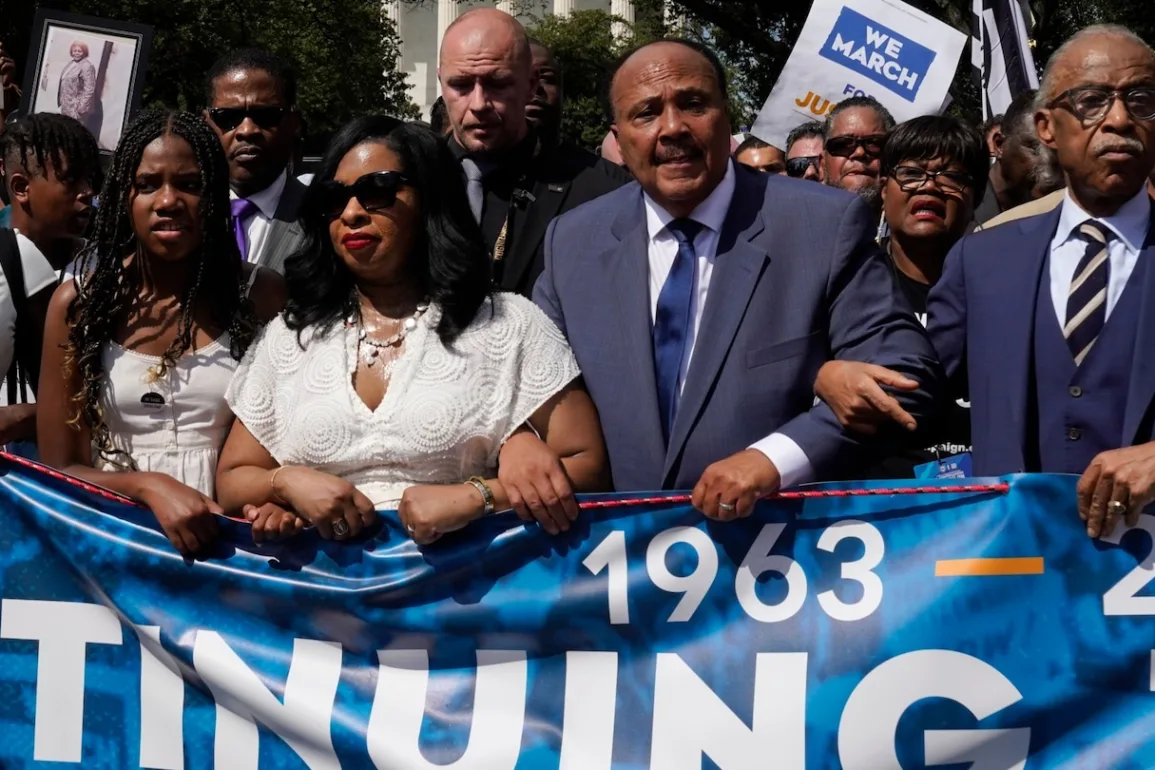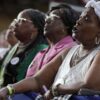Sixty years after the Rev. Martin Luther King Jr. led 250,000 people in the March on Washington for Jobs and Freedom, thousands of people gathered again at the Lincoln Memorial on Saturday to declare that King’s dream is newly threatened and the fruits of his work are at risk.
On a sweltering August day much like the one in 1963, marchers came from distant cities to the site where King stood to assert that his crusade was being assailed, that court rulings, legislation and political extremism have undone or stymied the racial and social progress of the last half-century.
“If I could speak to my grandfather today, I would say, ‘I’m sorry we still have to be here to rededicate ourselves to finishing your work, and ultimately realizing your hidden dream,’” King’s granddaughter Yolanda Renee King told the crowd.
Her father, King’s eldest son, Martin Luther King III, said: “I’m very concerned about the direction our country is going in. … Instead of moving forward, it feels as if we are moving backward.”
Democracy, voting rights and the rights of women and children must be protected, and gun violence must end, he said. Echoing the words of his father 60 years ago, he said, “then maybe one day we will be a great nation.”
The day-long rally consisted of speeches by leaders of civil and human rights groups, and representatives from an array of other organizations. Its organizers made clear that the march was not a commemoration, but a reassertion of the demands made at the memorial in 1963.
Speakers as varied as Sacha Baron Cohen who portrays the satirical character, Borat, and Robert Kraft, owner of the New England Patriots football team, addressed the crowd. Labor leaders, activists and politicians took their turns on the podium.
Among them was Andrew Young Jr., who at 91 is one of the last living civil rights leaders of his generation and was present for the 1963 march.
He reminded the crowd of the power of voting.
The ballot is “the passport to freedom and opportunity,” Young said, urging people to keep their focus forward.
“Don’t look at all the things that are wrong — look back at where we were … years ago when we had the first March on Washington,” said Young, whose career included turns as Atlanta mayor, a member of Congress and a United Nations ambassador.
Stepping up to the microphone later in the program, civil rights leader Rev. Al Sharpton, founder and president of the National Action Network, shouted, “No Justice!”
“No peace!” the crowded shouted back.
“We are the continuation of a movement,” he said. “They want to stop Blacks from voting? We’re going to vote anyhow. No matter how hard you make it, we’re coming anyhow … Our fathers fought for this, and we’re going to maintain it.”
House Minority Leader Hakeem Jeffries (D-N.Y.) said, “Sixty years later we’ve come a long way, but we still have some things that have to be worked out.”
Voting rights, reproductive rights, workers rights and rights for LGBTQ people had brought people here, “here to fight to make America the best version of herself,” he said.
College students, retirees, a psychotherapist, a landscaper, members of Black sororities and fraternities and a sprinkling of 1963 March veterans, among others, converged before the memorial to hear the speakers and be heard themselves. They carried signs that read “Stop Voter Suppression,” “Immigration is not a crime” and “Protect LGBTQ+ families.”
The day grew hot and humid as the sun passed over the Washington Monument in the distance, and the Lincoln reflecting pool, where in 1963 sweltering marchers cooled their feet. By late afternoon, it was in the 90s.
Avril Trancoso was one of dozens of people pressed against the metal barriers to get a better glimpse of the leaders on the podium on the Lincoln Memorial steps.
Trancoso, a Black immigrant from Trinidad and Tobago who worked for years as a nursing supervisor before retiring, traveled from Brooklyn with her family in mind.
“I’ve got three children, and I have nine grandchildren. I’ve always thought that what I have to do is just prepare them for a better world,” said Trancoso, who came to the United States 52 years ago. “We still have a long way to go.”
For her, the threat to Black progress was most symbolized by the Jan. 6, 2021, assault on the Capitol, which stood gleaming at the opposite end of the National Mall.
The ease with which the insurrectionists made their way into the seat of the U. S. government suggested to her that their grievances are much more likely to find sympathy, even though they represent a grave threat to democracy, she said.
“They were allowed to go in,” Trancoso said. “They were privileged to storm the Capitol, to want to lynch the vice president of America.” Had a Black mob tried to do such a thing, she said, they would have been gunned down.
Denorver Garrett Jr., with a turkey feather in his hair, moved through the crowd carrying an 80-pound wooden cross he made to call attention to gun victims and invited people to sign it.
“Let’s put the guns down, America,” he had written along the cross beam. Three nails dripped red paint to signify blood.
Dozens of names had been scrawled by people in heavy black ink.
Garrett explained why he, too, had made the trip from Louisville.
“Unity,” he said.
“We’re basically seeing what Martin Luther King said, that Black and White would come together to fight for the cause of freedom,” said Garrett, a landscaper who said he is mixed race, part White and Cherokee.
Elsewhere, about 60 students from Claflin University in Orangeburg, S.C., strode toward the stairs of the Lincoln Memorial.
Breeze Smith, a 20-year-old studio art major, called their presence on the National Mall on Saturday “kind of surreal.”
“I would read about it and see pictures,” she said. “Your grandparents might talk about it. But to be here is definitely a historical moment.”
The students said the culture wars surrounding teaching Black history in schools were worrisome.
“For them to be now attacking our curriculum — the written history — and taking that away from us, disarming us of knowledge … that’s a call of action of us to be here,” Smith said.
Across the reflecting pool, a group of White American University students were clustered beneath an elm tree.
Nicolo Potesta, a first-year student and a transgender man, said he was concerned about LGBTQ issues and Black rights under threat.
Potesta, an 18-year-old political science major from Seattle, said he in part chose to go to college in D.C. to attend marches and protests.
“I am transgender,” he said. “For me, seeing transgender rights be attacked all throughout the United States has just been really awful.”
“I would really like to see that amended,” he said. He also expressed solidarity with African Americans, whom he said “are still missing equality of opportunity.”
Helen Robinson, 75, sported a homemade straw hat with stickers held fast by safety pins and quotes from Gandhi. Robinson, who is White, said she was determined to be at the 60th anniversary March on Washington because “there’s so many voices that are saying things that are hateful,” she said.
She and Steve Skiffington, 77, who had come on a bus from North Carolina, said they believe White Americans are afraid of the changing demographics of the country.
Skiffington remembered where he was during the first March 60 years ago as a senior in high school in California. He wanted to go then, but his parents wouldn’t allow the 17-year-old to travel.
“But they’re dead now, and I’m here,” Skiffington said with a chuckle.
The crowd appeared to fall well short of the 75,000 people its organizers had estimated would attend. Tens of thousands from across the country came to the 1963 March, a gathering that helped spur the passage of the Civil Rights Act of 1964 — the most important civil rights legislation since the post-Civil War era of Reconstruction.
It outlawed segregation in theaters, restaurants and hotels, according to the National Archives. It banned discrimination in employment and ended segregation in public places such as swimming pools, libraries and public schools.
The Aug. 28, 1963, March was largely planned and executed by A. Philip Randolph, the president of the Brotherhood of Sleeping Car Porters and longtime dean of the Civil Rights movement, and chief organizer Bayard Rustin.
That day, the country was still trying to drag itself out of its 340-year legacy of the enslavement of millions of African Americans. One marcher getting off a train in Union station said “this is the greatest day since Emancipation.”
Even 100 years apart, the two events felt closely connected. It had been a bitter struggle since Abraham Lincoln’s 1863 proclamation of partial emancipation for the nation’s enslaved. A century of racial violence, oppression, segregation and discrimination had followed and still menaced African Americans.
The months leading up to the 1963 March were bloody and full of conflict between activists and racists.
In June 1963, 37-year-old civil rights leader Medgar Evers was assassinated by a Ku Klux Klan member outside Evers’s home in Jackson, Miss. The day before, Alabama Gov. George Wallace had tried to physically block the integration of the University of Alabama.
In Birmingham, Ala., that spring, police used dogs and fire hoses to try to disperse demonstrators, many of them children, and imprisoned hundreds who were protesting the city’s racist and segregationist policies.
King and other civil rights leaders had been arrested in Birmingham in April and jailed for parading without a permit. Confined under harsh conditions, King wrote his historic “Letter from Birmingham Jail.”
“I am in Birmingham because injustice is here,” he wrote. “Injustice anywhere is a threat to justice everywhere. We are caught in an inescapable network of mutuality, tied in a single garment of destiny.”
After the speeches on Saturday, the crowd marched a half-mile to the Martin Luther King, Jr. Memorial, where a commanding 30-foot-tall granite statue of King overlooks the Tidal Basin.
The statue stands across the water from the memorial to Thomas Jefferson, who wrote in the Declaration of Independence that “all men are created equal,” but who was the owner of people he enslaved.



